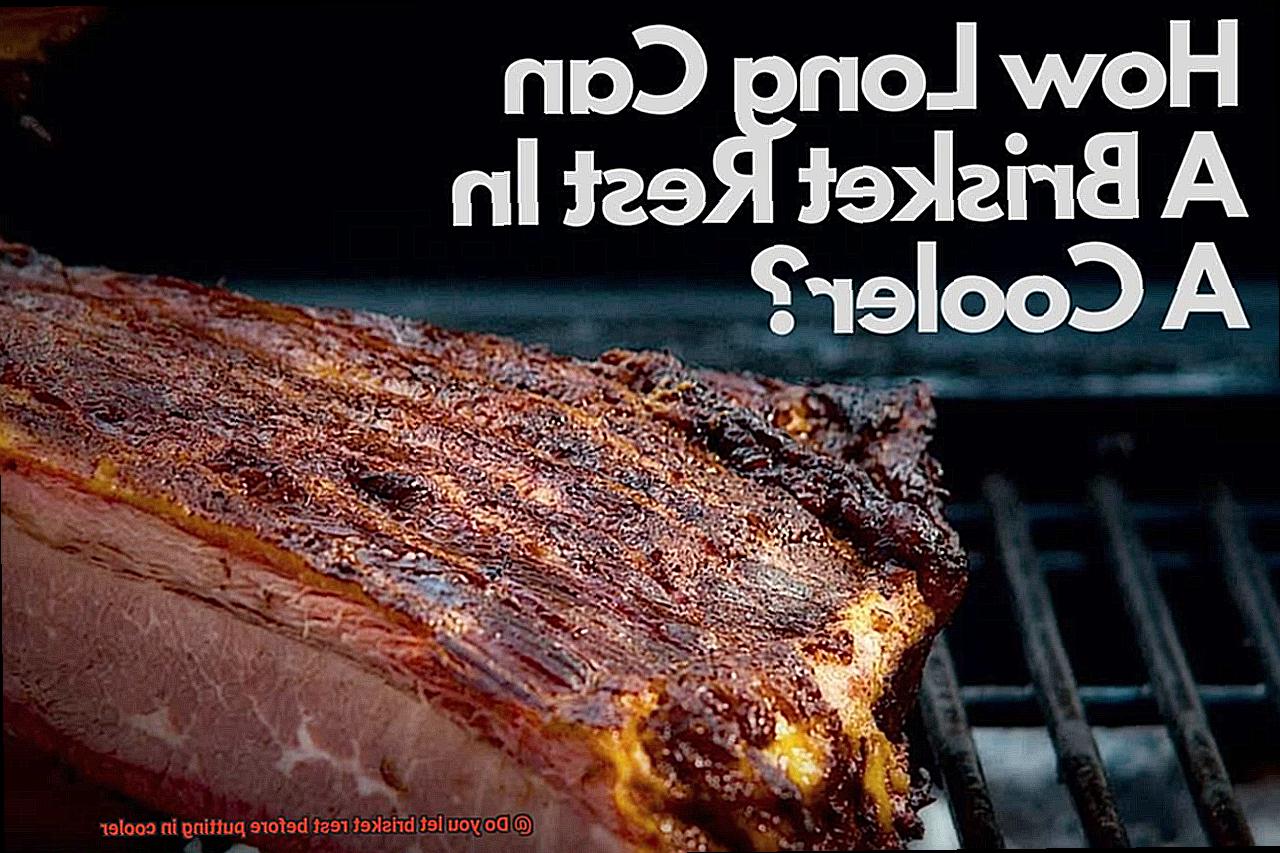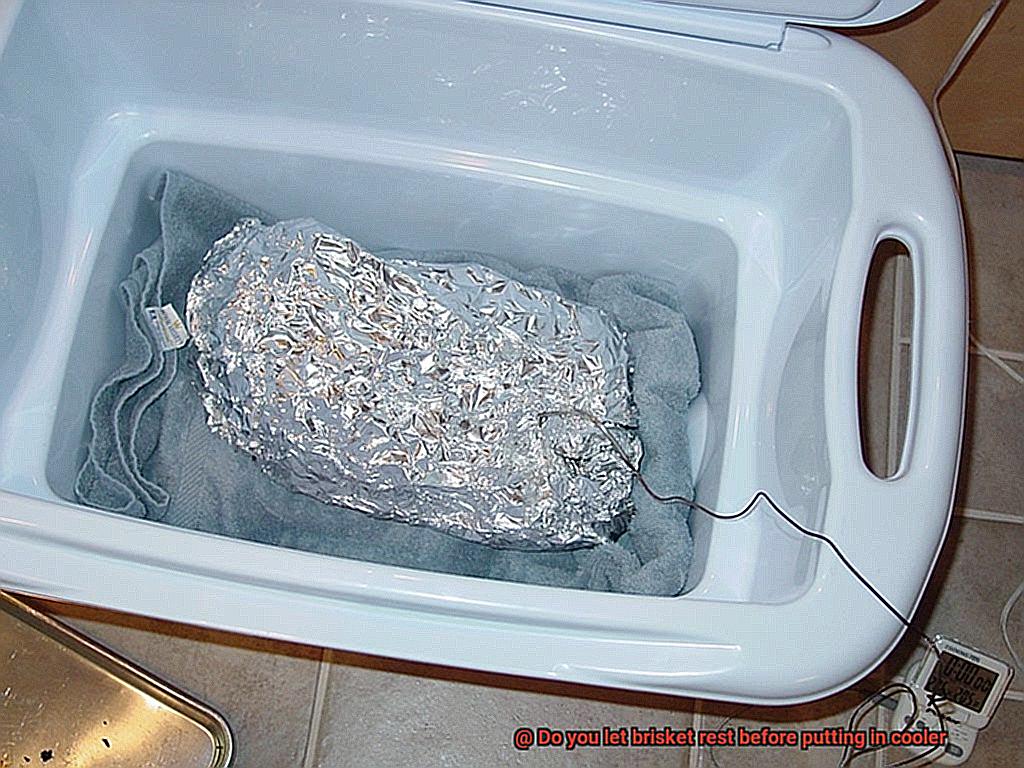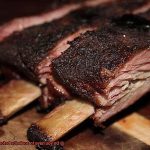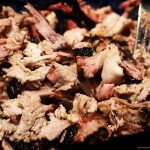Picture this: you’ve just spent hours perfecting your brisket recipe, lavishing it with mouthwatering seasonings and patiently smoking it to tender, succulent perfection. But here’s a little secret that could take your brisket game to a whole new level: letting it rest before tossing it in the cooler. Now, I know what you’re thinking—waiting even longer for that tantalizing masterpiece? But trust me, my friend, this crucial step can be a game-changer in your barbecue journey.
Think of resting your brisket as giving it a well-deserved timeout after an intense workout. While the meat is cooking, those precious juices are pushed towards the surface, resulting in those delectable caramelized crusts we all crave. But here’s the catch—when you hastily chuck the brisket into a cooler without allowing it to rest, those flavorful juices will make a swift escape, leaving you with a dry and lackluster end product. And believe me when I say that we don’t want that to happen.
By granting your brisket some downtime, you’re giving those muscle fibers a chance to unwind and soak up all those delicious juices that have gathered during its time on the grill. This crucial resting period not only redistributes the juices evenly but also helps the meat retain moisture, ensuring each bite is bursting with flavor and tenderness.
Now comes the million-dollar question: how long should you let your brisket rest? Well, my friend, patience is key here. Ideally, give it at least 30 minutes of uninterrupted relaxation before even considering transferring it to a cooler. This allows the internal temperature to stabilize and gives all those flavors time to mingle together harmoniously.
So, next time you find yourself itching to rush through the process, remember that achieving melt-in-your-mouth brisket lies in this vital resting period. Grab yourself a refreshing beverage, take a breather, and let your brisket work its magic. Trust me, the results will be well worth the wait.
Stay tuned for our next blog post, where we’ll unveil some expert tips on getting that perfect crust on your brisket. Get ready to elevate your barbecue game like never before.
Contents
What is Brisket?

What exactly is brisket, and how can you unlock its full potential? In this comprehensive guide, we will embark on a culinary adventure, exploring the different cuts of brisket, various cooking methods, and the essential step of resting before serving.
Understanding Brisket:
Brisket hails from the lower chest or breast area of a cow. It consists of two magnificent muscles – the flat and the point. The flat, also known as the “lean” or “first cut,” boasts a leaner composition that lends itself perfectly to slicing. On the other hand, the point, with its abundant marbling and rich flavor, is ideal for creating succulent burnt ends or indulgent chopped beef.
Cooking Methods:
- Smoking: Smoking is a beloved method among barbecue aficionados as it infuses the meat with a distinct smoky essence. After applying a dry rub or marinade, the brisket is lovingly placed in a smoker for several hours. The gentle heat and slow cooking process unravel collagen and render fat, resulting in a melt-in-your-mouth texture that is pure bliss.
- Roasting: Roasting is another favored technique for cooking brisket. Once seasoned and seared to perfection, the brisket takes center stage in the oven at a low temperature for an extended period. This unhurried roasting allows the meat to become exquisitely tender while developing a mouthwatering crust that enhances its flavors.
- Braising: Braising presents a tantalizing option for transforming brisket into a culinary masterpiece. The process begins with a sizzling sear to create a luscious caramelized exterior before immersing the brisket in a flavorful liquid, such as broth or wine, for slow cooking at a low temperature. This moist environment further breaks down collagen and imparts an irresistible depth of flavor.
The Importance of Resting:
Resting the brisket serves as a vital step in the cooking process, ensuring optimal tenderness and succulence. Allowing the brisket to rest permits the internal temperature to stabilize, muscle fibers to relax, and juices to harmoniously redistribute within the meat. The result is an explosion of flavors that tantalize the taste buds and make every bite memorable.
To rest the brisket, gently remove it from the heat source and place it on a cutting board or platter. Embrace its beauty by loosely tenting it with aluminum foil, preserving its warmth and integrity. The resting period typically lasts between 30 minutes to an hour, depending on the size of the brisket.
Why Resting Brisket is Important
Resting brisket is not just a mere step in the grilling process; it is an essential one that should never be overlooked. When that perfectly cooked brisket comes off the grill, it may be tempting to dive right in, but taking the time to let it rest can make all the difference in terms of flavor and texture. So, why exactly is resting brisket so crucial for grilling? Let’s explore the reasons why.
- Relaxation and Reabsorption: When brisket is cooked, the heat causes the muscle fibers to contract, squeezing out precious moisture. Resting allows these fibers to relax and reabsorb those flavorful juices. This results in a final product that is not only more tender but also incredibly juicy. The mere thought of a succulent, melt-in-your-mouth brisket should be reason enough to make resting a non-negotiable part of your grilling routine.
- Even Distribution: During the cooking process, the natural juices tend to collect in certain areas of the meat. By allowing the brisket to rest, these juices have an opportunity to redistribute, ensuring that each bite is bursting with flavor and moistness. Resting ensures a harmonious distribution of those delicious juices throughout the entire brisket.
- Perfect Slicing: Slicing a brisket can be a challenge if it hasn’t been given time to rest. When meat is cooked, its proteins tighten up, making it difficult to achieve clean and even slices. Resting allows these proteins to relax, resulting in beautifully sliced brisket that will impress even the most discerning guests. Your presentation will be elevated as you effortlessly carve through tender layers of perfectly cooked meat.
- Deepened Flavors: While resting, the flavors of the brisket continue to deepen and develop further. As residual heat continues to cook the meat slightly, it enhances its taste, providing an opportunity for a more flavorful end result. This extra time allows the flavors to meld together, creating a symphony of savory perfection that will leave your taste buds begging for more.
So, how long should you let your brisket rest? While there are no hard and fast rules, a good guideline is to let it rest for at least 30 minutes to an hour. This provides ample time for the meat to relax, reabsorb its juices, and reach that optimal tenderness without getting too cold.
Remember, resting does not mean leaving your brisket out at room temperature. After cooking, tent it with foil or wrap it in butcher paper and place it in a cooler or warm oven to keep it at a safe temperature while it rests.
How Long to Rest a Brisket?
Resting a brisket is a crucial step in the cooking process that can transform your meat from good to extraordinary. It allows the meat to reabsorb its flavorful juices, resulting in a tender and succulent final product. So, how long should you rest a brisket? The general consensus among experts is that it should rest for at least 30 minutes to an hour before slicing.
During this resting period, the temperature of the brisket will continue to rise slightly as the residual heat redistributes throughout the meat. This ensures that every slice is juicy and flavorful, hitting all the right notes in a symphony of flavors.
Some pitmasters take resting a step further and recommend resting for up to two hours or longer, depending on the size and tenderness of the meat. However, be careful not to let it rest for too long, as it may start to cool down and lose some of its desired warmth.
Resting also allows the muscle fibers in the brisket to relax, making it easier to slice without it falling apart. Trust me, there’s nothing worse than trying to cut into a brisket only for it to crumble into pieces.
To achieve the perfect resting time, use a meat thermometer to ensure that the internal temperature of the brisket reaches around 200°F (93°C) before removing it from the heat source. Once it’s done, loosely tent it with foil to retain heat and allow for proper resting.
Now, here comes the hard part – resisting the temptation to cut into that beautiful brisket immediately. Give it some time to rest and let those juices redistribute throughout the meat. Use this time to prepare any sides or sauces that will accompany the brisket, allowing anticipation to build for the flavorful meal that awaits.
Benefits of Resting Brisket
Imagine the anticipation as the smoky aroma fills the air, and your grill crackles with excitement. You’re about to indulge in a perfectly cooked brisket, but before you dig in, there’s a crucial step that elevates the flavor and tenderness to unparalleled heights – resting. In this article, we’ll delve into the benefits of resting brisket and uncover why it’s an indispensable part of the grilling process.
Reabsorbing Juices for Juicy Bliss:
When you allow your brisket to rest, something magical happens. The meat reabsorbs its flavorful juices, resulting in a tantalizingly juicy and succulent final product. Each mouthwatering bite bursts with moisture and flavor, transforming your brisket from good to extraordinary.
Tenderizing the Meat Fibers:
During the cooking process, the resilient muscle fibers in the brisket tighten and contract, potentially rendering the meat tough and chewy. However, through the power of resting, these fibers relax, becoming tender and creating a melt-in-your-mouth experience that will leave your guests begging for seconds.
Moisture Redistribution for Even Texture:
Bid farewell to dry patches and welcome an evenly textured brisket with open arms. Resting plays a pivotal role in redistributing moisture throughout the meat, ensuring that every slice is moist and succulent. No more disappointments or dry bites – just pure gustatory satisfaction.
Flavor Development: Let It Marinate.
Resting isn’t solely about texture; it’s a catalyst for flavor development. As your brisket rests, the flavors meld together, intensifying their harmony and creating a symphony of taste that will have your taste buds dancing with delight. Let patience be your secret ingredient for a flavor-packed masterpiece.
Slicing with Ease:
Imagine wielding your knife and slicing into a hot brisket, only to witness precious juices escape, leaving you with drier slices. Resting before slicing helps retain those coveted juices, ensuring that each slice is moist and bursting with flavor. Furthermore, rested brisket is easier to slice, resulting in clean cuts with defined edges that are visually appealing when serving.
Presentation Matters:
Remember, presentation is the gateway to a culinary masterpiece. Resting not only benefits the taste but also enhances the visual appeal of your brisket. With cleaner cuts and well-defined edges, your guests will be captivated by the appetizing sight of your grilled creation. Leave them in awe as they savor every delectable bite.
Properly Resting a Brisket
Look no further than the often overlooked, yet essential step of properly resting a brisket. As a grill enthusiast, understanding the importance of resting and mastering the art of timing can make all the difference in achieving that melt-in-your-mouth tenderness and flavor explosion. So, grab your tongs and let’s dive into the world of brisket resting.
The Key Benefits of Resting:
Resting a brisket is not just an arbitrary step; it holds several key benefits that result in an exceptional final product. Here’s why it matters:
- Tenderizes the meat fibers: Allowing the brisket to rest gives ample time for the meat fibers to relax, resulting in an incredibly tender texture.
- Ensures even texture through moisture redistribution: During resting, residual heat evenly distributes throughout the meat, preventing dry spots and ensuring a succulent bite every time.
- Creates a symphony of flavors: Resting allows the flavors to meld together, transforming your brisket into a harmonious explosion of taste.
- Retains precious juices while slicing: Resting helps the juices settle back into the meat, preventing them from escaping when you slice into it, resulting in juicy perfection.
How Long Should You Rest Your Brisket?
While a general guideline is to rest your brisket for at least 30 minutes to an hour after cooking, several factors come into play when deciding on the perfect resting time:
- Personal preference: Some pitmasters prefer shorter rests for a firmer texture, while others opt for longer rests to achieve maximum tenderness.
- Cooking method: Different cooking methods may require varying resting times. Experimentation will help you find your perfect balance.
- Serving time considerations: If you plan to serve immediately after resting, go with a shorter rest. However, if you need to delay serving, a longer rest will keep the brisket warm and flavorful.
The Resting Process:
To properly rest your brisket, follow these steps:
- Remove from heat: Take your brisket off the heat source and place it on a cutting board or platter.
- Tent with foil: Loosely tent the brisket with foil to retain warmth, but avoid tightly wrapping it as this can affect the crispy bark.
- Embrace patience: Allow the brisket to rest without slicing into it immediately. Patience is key to preventing dry meat.
- Preheat serving platter or plates: If serving right away, preheating your platter or plates will keep the meat warm for longer.
Food Safety Considerations
Well, we’ve got an essential ingredient for you – food safety considerations. You might be wondering, what does food safety have to do with grilling? Trust me, it’s crucial not only for the taste and texture of your brisket but also for your health. So, let’s dive into the sizzling world of food safety considerations when handling and storing that beautiful cut of brisket.
Temperature Danger Zone:
Imagine this: you’ve just cooked the perfect brisket, and now it’s time to let it rest. But beware – there’s a danger lurking in the shadows called the temperature danger zone. This range between 40°F and 140°F is where bacteria thrive. To minimize bacterial growth, keep your brisket out of this zone as much as possible.
The Two-Hour Rule:
To ensure food safety, follow the two-hour rule. Don’t let your brisket hang out at room temperature for more than two hours. And if it feels like you’re grilling under the scorching sun, reduce that time to one hour. Remember, bacteria can double every 20 minutes within the temperature danger zone, so don’t give them a chance to party.
Steps for Safe Handling and Storage:
Now that we know the basics, let’s talk about how to handle and store your brisket safely.
- Use a food thermometer: Get technical. Grab a reliable food thermometer to check if your brisket has reached a safe internal temperature. For medium-rare, aim for 145°F; for medium doneness, go for 160°F. This ensures those pesky bacteria are eradicated.
- Resting is key: After cooking, let your brisket rest on a clean cutting board or plate for 10-20 minutes. This allows the meat’s internal temperature to stabilize and the juices to redistribute, creating a tender and flavorful masterpiece. Just make sure your resting area isn’t a hot spot for bacteria.
- Transfer to the cooler: Once the resting period is over, swiftly transfer your brisket to a cooler or refrigerator to cool it down rapidly. Keep it airtight in an appropriate container or wrap it tightly with foil or plastic wrap to prevent contamination and slow bacterial growth.
- Monitor that temperature: Keep a close eye on the temperature of your cooler or refrigerator. It should be below 40°F to keep those bacteria at bay. A refrigerator thermometer is your trusty sidekick in ensuring your brisket stays safe and delicious.
Different Factors for Rest Time
Resting a mouthwatering brisket is the final step in achieving that perfect tender and flavorful result. But determining how long it needs to rest depends on various factors that must be taken into account.
Firstly, the size of the brisket plays a significant role. Smaller cuts require a shorter rest time of around 30 minutes, while larger ones need an hour or more. The mass of a larger brisket takes longer to cool down and redistribute its juices, resulting in a longer resting period.
The cooking method used also affects the rest time. If you opt for the low and slow approach, like smoking your brisket, it will require more time to rest compared to high-heat grilling. The gradual breakdown of connective tissues in the low and slow method demands a longer resting period for optimal tenderness.
The internal temperature is crucial as well. Aim for an internal temperature of approximately 200-205°F before removing the brisket from the heat source. Once it reaches this temperature, allow it to rest. The duration can range from 10 minutes to over an hour, depending on the size and cooking method.
Don’t overlook the influence of ambient temperature. On a scorching hot day, your brisket may cool down faster, necessitating a shorter rest time. Conversely, on chilly days, your meat will retain heat longer, requiring a longer resting period.
Lastly, personal preference cannot be ignored. Some individuals prefer a firmer texture and opt for a shorter rest time, while others crave that melt-in-your-mouth tenderness and choose a longer rest.
JTVVfsSeZ84″ >
Conclusion
Yes, it is crucial to let brisket rest before putting it in the cooler. Allowing the meat to rest after cooking is like giving it a chance to catch its breath and settle into its full flavor potential. Resting allows the juices to redistribute throughout the meat, ensuring a moist and tender final product. It’s like a symphony of flavors harmonizing together, creating a mouthwatering melody that will leave your taste buds dancing with delight.
By letting brisket rest before cooling, you are giving it the respect it deserves. Just imagine a world-class athlete finishing a race and immediately collapsing without taking a moment to recover and bask in their accomplishment. It’s the same principle with brisket – by allowing it to rest, you are honoring all the time and effort that went into preparing and cooking it.
So how long should you let your brisket rest? Well, patience is key here. A general rule of thumb is to let it rest for at least 30 minutes, but some pitmasters even recommend up to two hours for larger cuts of meat. This resting period not only enhances the tenderness but also allows the flavors to deepen and develop further.
Once your brisket has had its well-deserved rest, then it’s time to carefully transfer it into a cooler for safe storage or transportation. Make sure to wrap it tightly in foil or butcher paper before placing it in the cooler to lock in all those delicious juices.
In conclusion, letting brisket rest before putting it in the cooler is an essential step towards achieving barbecue perfection. It’s like allowing a beautiful piece of art to dry before framing it – you want all those flavors and textures to settle and meld together for an unforgettable dining experience.






